The ocean has long been an intriguing place for many people to explore, but its creatures are considerably more fascinating than its waters. There is so much unexplored life in the water. Although we know a lot more about life on land, our understanding of marine life is still very limited even to this day.
The Ocean Photographer of the Year award winners were announced in September 2022 (find previous posts here and here). According to the official website, the award serves as a celebration and awareness of our planet's oceans and will donate 20% of the profit generated in the contest to the preservation of the oceans.
The award brings together amateurs and professionals to celebrate the importance of marine life. Throughout all categories, there were nine winners in total.
More info: oceanographicmagazine.com | Instagram | twitter.com | Facebook
#1 1st Place, The Ocean Photographer Of The Year
Ben Thouard, French Polynesia. The moment a surfer gets wiped out and worked by the turbulence of one of the heaviest waves in the world. "This is the unseen part of surfing," says photographer Ben Thouard. "I have so much respect for both the wave and the surfers - surfing such a heavy wave is a huge challenge."
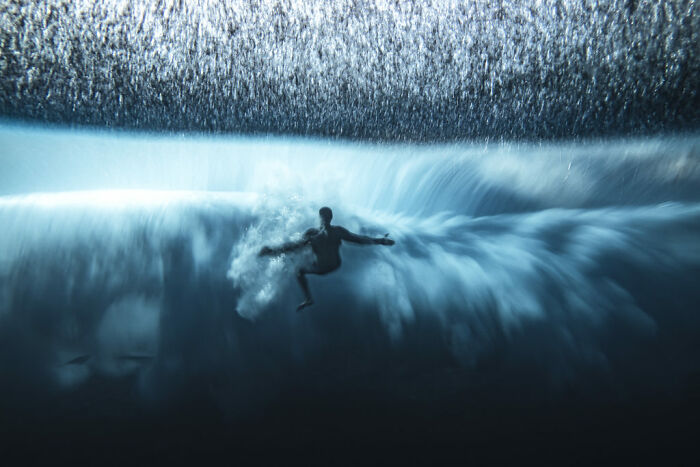
Image credits: oceanphotographyawards
#2 Finalist, Wildlife Photographer Of The Year
Nadia De Lange, Svalbard, Norway.
Two polar bear cubs cozy up to their mother. Security and warmth.
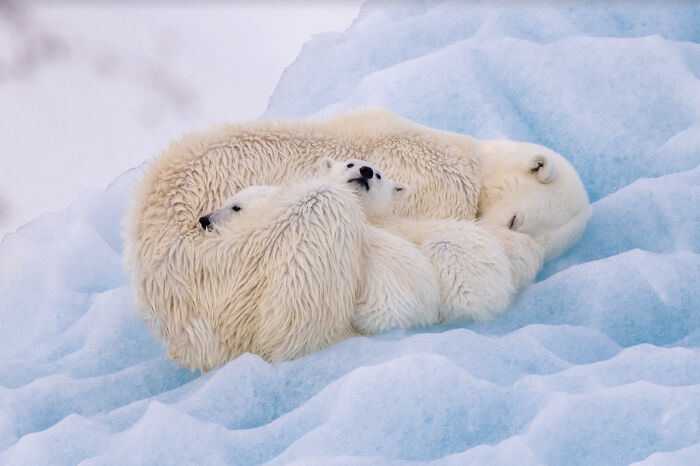
Image credits: oceanphotographyawards
#3 Finalist, Human Connection Award: People & Planet Ocean
Reiko Takahashi, Japan. A narrow waterway alongside a busy resort in Kagoshima is home to a bloom jellyfish during the short summer period.
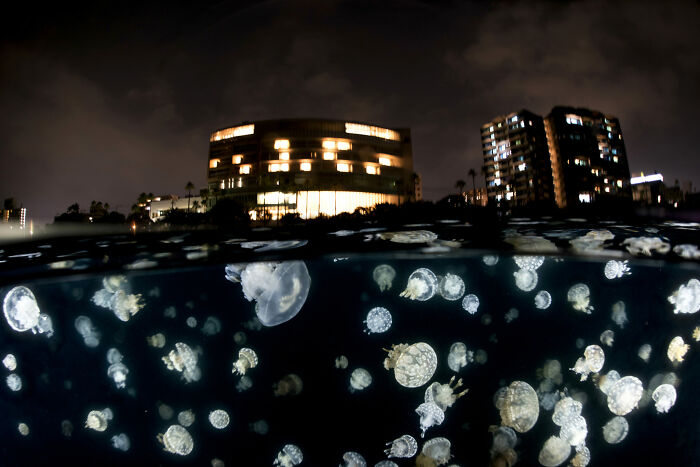
Image credits: oceanphotographyawards
#4 Finalist, Conservation (Hope) Photographer Of The Year
Ellen Cuylaerts, Canada. "Every year harp seals make their journey from the Greenland area to fast ice floes in the Gulf of St. Lawrence to give birth to their pups at end of February / early March," says photographer Ellen Cuylaerts. "The mothers feed the pups for just two weeks with milk rich in fat and nutrients. Soon the mothers abandon their pups to join the males for courting and mating, leaving the vulnerable white young on the ice until they moult, lose most of their reserves and learn to swim and hunt by themselves. During this time they fully depend on strong sea ice that lasts at least another four weeks."
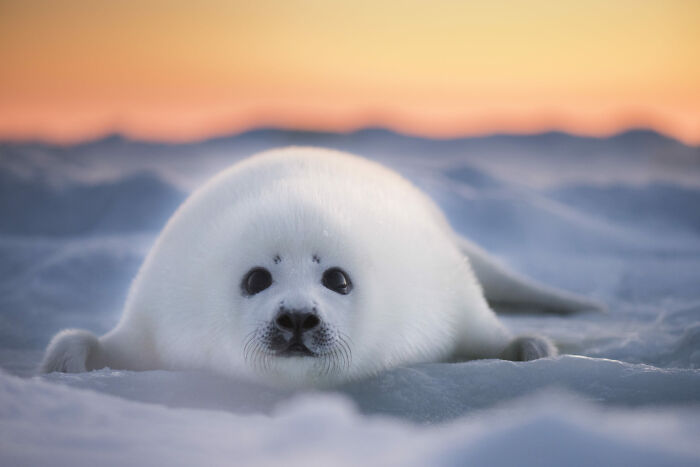
Image credits: oceanphotographyawards
#5 3rd Place, Conservation (Impact) Photographer Of The Year
Dmitry Kokh, Russia. Polar bears make a 'home' of an abandoned station on Kolyuchin Island, in the Russian high Artic.
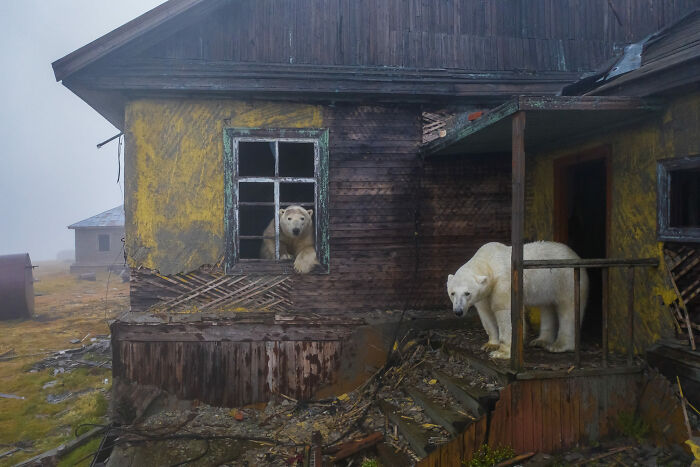
Image credits: oceanphotographyawards
#6 Finalist, Conservation (Impact) Photographer Of The Year
Florian Ledoux, Svalbard, Norway. Aerial view of a large male polar bear roaming Arctic's rapidly thinning and melting spring ice. "Spring had arrived and the ice was melting during this shoot," says photographer Florian Ledoux. "This male bear went through the ice on a couple of occasions, swimming for stretches, but he had a quest - he was tracking the scent of a female."

Image credits: oceanphotographyawards
#7 3rd Place, Conservation (Hope) Photographer Of The Year
Renee Capozzola, Hawaii. Three green sea turtles gather under the sun in Maui, Hawaii. "Turtles thrive in Hawaii thanks to the legal protections they are provided."
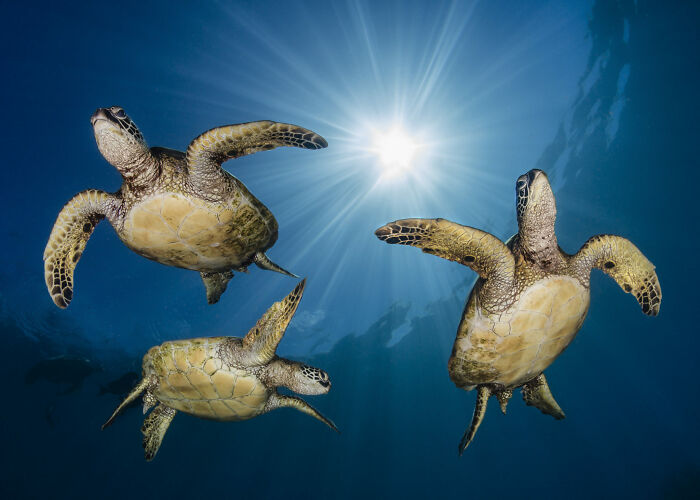
Image credits: oceanphotographyawards
#8 3rd Place, The Ocean Photographer Of The Year
Brook Peterson, The United States.
A cormorant and baitfish form the shape of a human face. "This image was made under the oil rig platform, Ellen, off Los Angeles, California," says photographer Brook Peterson. "There was a large school of baitfish under the platform for several weeks and, as a result, numerous other animals there to feed off the baitfish - sea lions, bonita, and cormorants. The image depicts a cormorant hunting through a large bait ball."
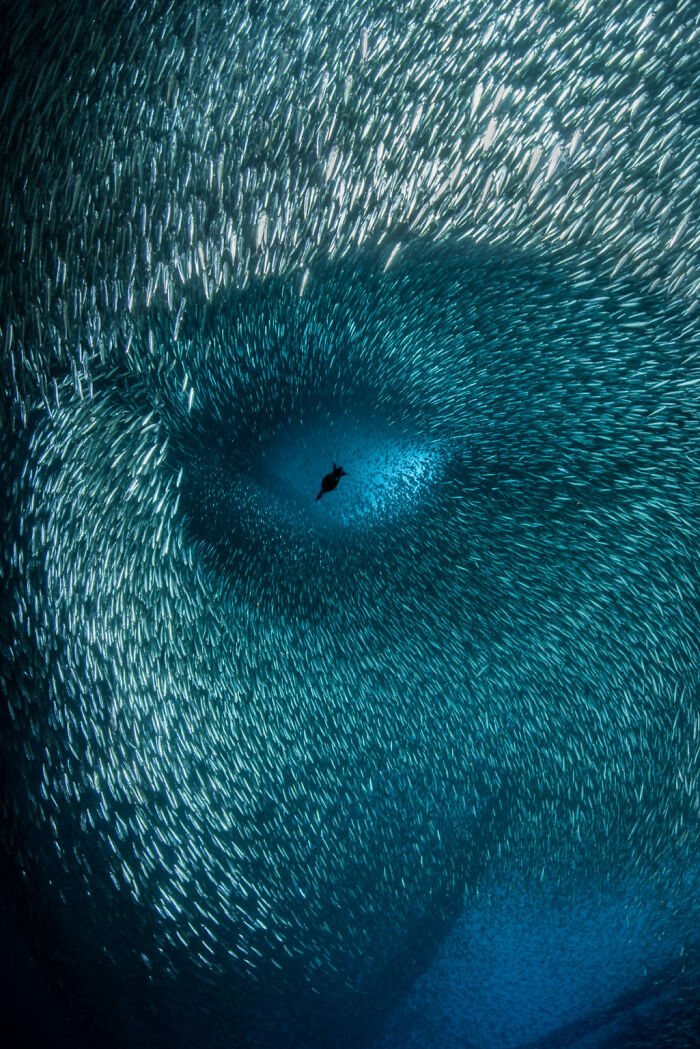
Image credits: oceanphotographyawards
#9 1st Place, Wildlife Photographer Of The Year
Rafael Fernandez Caballero, Strait Of Gibraltar, Spain. A pod of pilot whales pose for a family portrait. "Pilot whales are incredibly special and intelligent beings that enjoy tight family bonds," says photographer Rafael Fernandez Caballero. "They are curious and territorial, so most encounters involve them coming close to see what you want. With love and respect most moments are about a unique interaction, playful moments with different members of each family. This particular picture represents one of the first encounters of that day. A whole family came together to welcome me and to make sure I wasn't a threat."
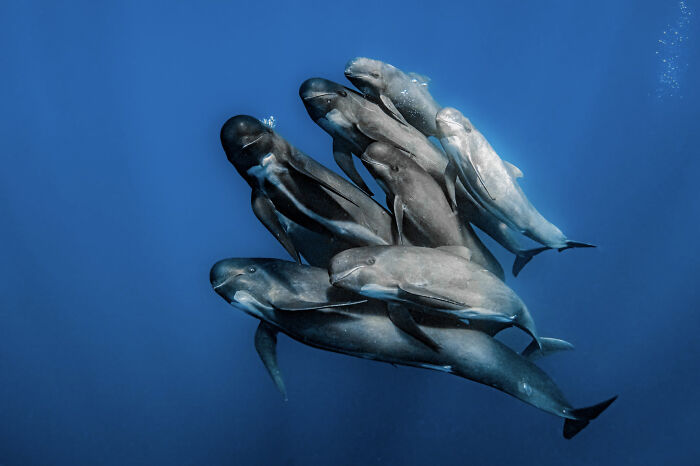
Image credits: oceanphotographyawards
#10 Finalist, Wildlife Photographer Of The Year
Rafael Fernandez Caballero, Bermeo, Spain. Mako shark at sunset. "Mako sharks are the fastest animal in the ocean," says photographer Rafael Fernandez Caballero. " Spending sunset with a predator like this is magical. Not only for creating pictures, but for witnessing it speeding along amongst the orange rays. It makes your heart beat a little faster. Mako sharks are endangered and, according to some scientific studies, face extinction in just a few decades."
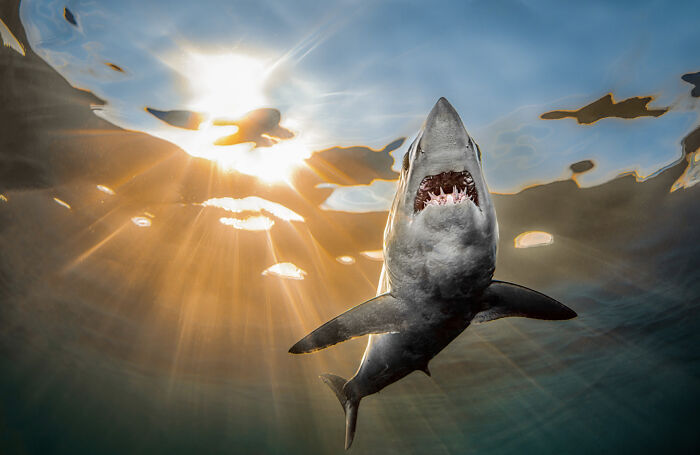
Image credits: oceanphotographyawards
#11 Finalist, Wildlife Photographer Of The Year
Sean Scott, Cape Arid National Park, Western Australia. Southern right whales off a beach in Western Australia. "This is a drone image taken in Cape Pasley in Western Australia," says photographer Sean Scott. "This is a remote part of the incredible Western Australia coastline. The beauty and ruggedness of the Cape Arid National park is second to none and is one of my favourite places in the world to explore. With my outback photography 4WD I camped out down here for more than a week to photograph and watch the beautiful southern right whales as the families socialised in some of the clearest water in the world. They travel up from Antarctica and hit the coast here before heading back."
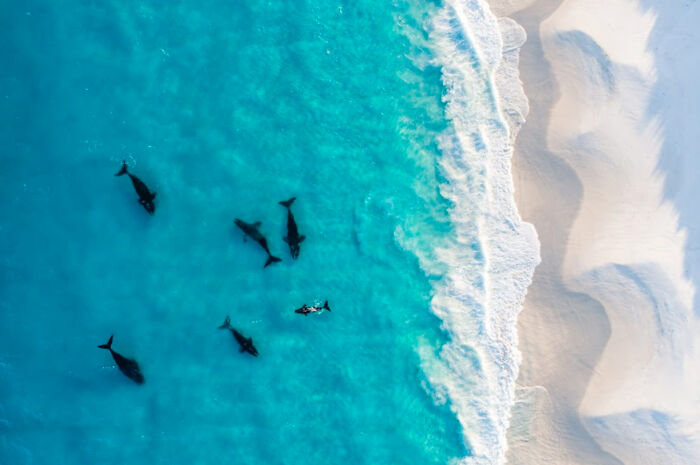
Image credits: oceanphotographyawards
#12 Finalist, Wildlife Photographer Of The Year
Simone Caprodossi, Baja California, Mexico. A brown pelican makes the most of fishing boat scraps. "Brown pelicans gather is numbers in ports and landing sites for fishing boats along the coast of Baja California," says photographer Simone Caprodossi. "We spent two days at an historical shark landing site off Bahia Magdalena engaging with the pelicans as they approached the fishing boats ready to take advantage of the fish scraps that are disposed of from the nets. The competition for the discarded catch is fierce with several pelicans swinging their beaks at the same time, pouch open to catch the easy meal. This clever pelican managed to push back its rivals with his open wings, protecting his catch at the same time."
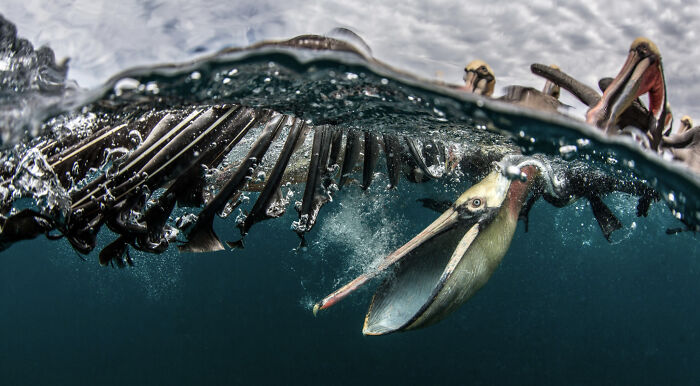
Image credits: oceanphotographyawards
#13 Finalist, Fine Art Photographer Of The Year
Vanessa Mignon, Australia. "Port Jackson sharks congregate in Jervis Bay during winter and spring in order to breed," says photographer Vanessa Mignon. "I had tried several times to photograph a shark over the kelp but never got the right conditions - until the weather was perfect. I saw several sharks but most of them were quite deep or resting on the sand or under rocks. The water was cold and after 45 minutes I started shivering. But I persisted. Eventually this shark swam slowly on top of the kelp, possibly looking for a mate, a place to lay an egg, or a place to rest."

Image credits: oceanphotographyawards
#14 1st Place, Young Photographer Of The Year
Ryuta Ogawa, Japan. A baby green sea turtle photographed at the Ogasawara Islands, Japan. "The baby turtles born on the islands have to migrate more than 1000km north to their feeding habitat," says photographer Ryuta Ogawa. "I came across this hatchling in the shallows. It almost looked as if it was calmly preparing for its long journey ahead. I waited for the moment it surfaced for a breath of air to get this particular shot."
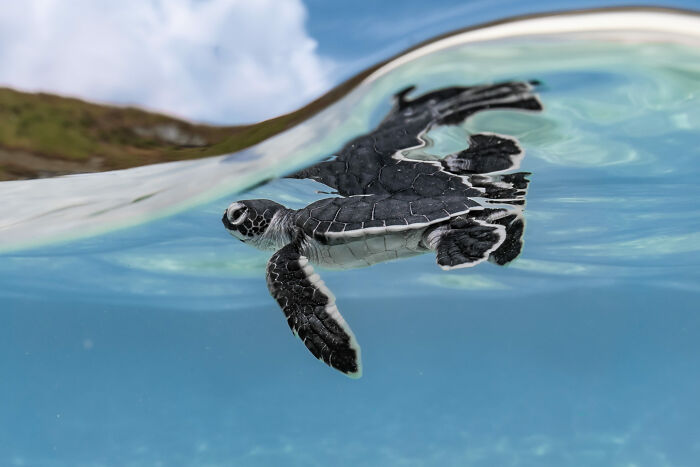
Image credits: oceanphotographyawards
#15 2nd Place, Conservation (Hope) Photographer Of The Year
Andreas Schmid, Maldives. "Because this was the last dive on a liveaboard trip before I flew out early the next day I had to stay shallow while everybody else went deep," says photographer Andreas Schmid. "This allowed me to play around with what the site has to offer in the shallows without any other divers around: schooling bannerfishes and pink whiprays."

Image credits: oceanphotographyawards
#16 Finalist, Human Connection Award: People & Planet Ocean
Tom Vierus, French Polynesia. Shark scientists attach a temperature logger to the dorsal fin of a newborn blacktip reef shark in the shallow waters just off Moorea, French Polynesia. "During fieldwork, the young sharks are captured with a gillnet, measured, tagged and released and some individuals received temperature loggers as seen in this photo," says photographer Tom Vierus. "These loggers will record the surrounding water temperature for as long as they are attached and once retrieved will aid the scientists in understanding how warming waters affect the physiology and ecology of young sharks."

Image credits: oceanphotographyawards
#17 2nd Place, Human Connection Award: People & Planet Ocean
Simon Lorenz, Sri Lanka. "When searching for whales in the open ocean we always inspect islands of flotsam as they can be interesting wildlife aggregators," says photographer Simon Lorenz. "This large ghostnet island was a death trap for an Olive Ridley sea turtle which we found entangled and struggling. She still looked healthy and strong so, when approaching her we had to be careful not to aggravate her. Getting her disentangled took a machete and more than 30 minutes of hard work. When all the netting was removed we checked the turtle over and sent her on her way."

Image credits: oceanphotographyawards
#18 1st Place, Human Connection Award: People & Planet Ocean
Steve Woods, Dominica. "This particular female sperm whale kept falling asleep in front of us, then waking up and investigating us again," says photographer Steve Woods. "On one occasion, as she did this in a patch of Sargassum seaweed, I managed to capture this image of a good friend who dived down for a moment with her."
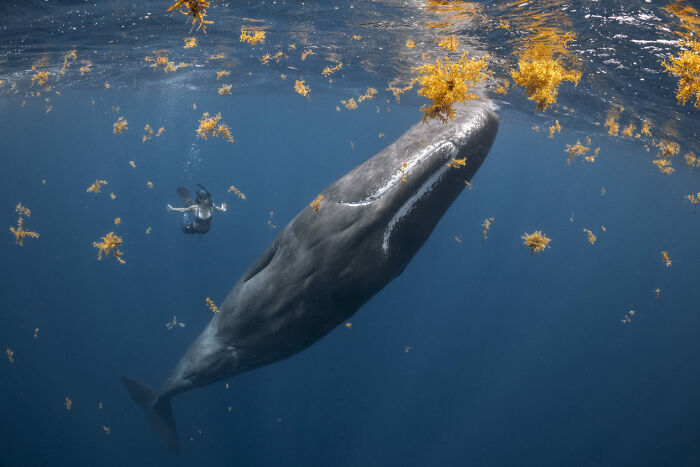
Image credits: oceanphotographyawards
#19 Finalist, Wildlife Photographer Of The Year
Magnus Lundgren, Philippines. A beautiful juvenile scalloped ribbonfish. "This image was captured in open water while earthquakes were rolling like thunder underwater," says photographer Magnus Lundgren. "As an adult this fish looks like another species, much bigger, shiny silver, with red markings. Sometimes ribbonfish are called “earthquake fish” because they have appeared as adults on the ocean's surface following major earthquake events."
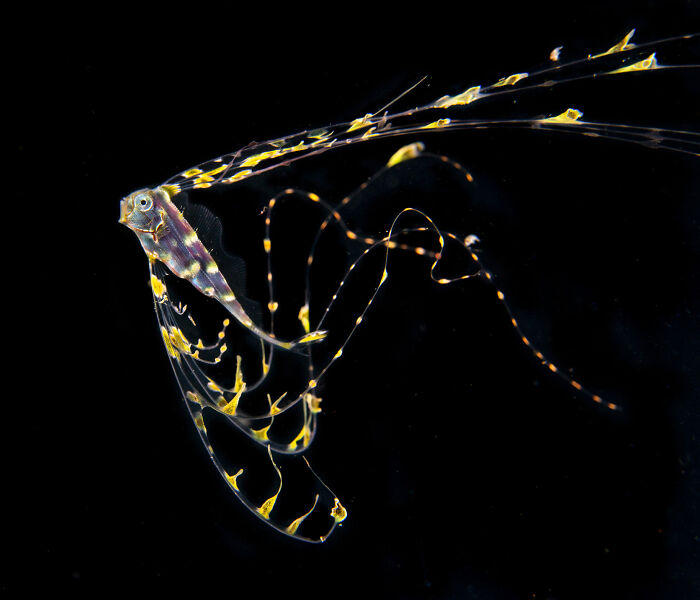
Image credits: oceanphotographyawards
#20 Finalist, Wildlife Photographer Of The Year
Andreas Schmid, Norway. An orca mother and her calf. "This was the most beautiful day I've had in Northern Norway," says photographer Andreas Schmid. "The mother stayed in front of her calf while they swam past me, making sure I couldn't get too close while still giving the calf a chance to have a good look at me. During the winter months the sun above the Arctic circle is very low or doesn't even rise at all. The window for in-water whale encounters with bright light and sunrays is short. Out of dozens of days this was the only time it all came together."
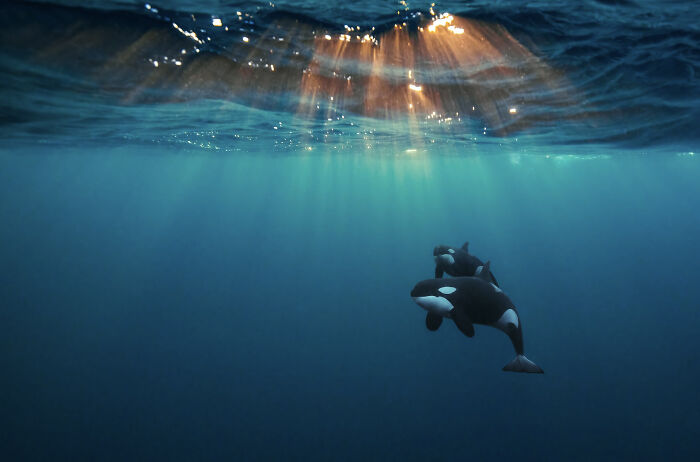
Image credits: oceanphotographyawards
#21 Finalist, Human Connection Award: People & Planet Ocean
Brook Peterson, Egypt. "I was waiting for sunset so that I could take some split shots showing the beautiful corals under the water when several snorkelers came down the pier and prepared to get in," says photographer Brook Peterson. "I realised the best story my image could tell was how people enjoy the sea and its beautiful corals, so I made this image with that intent."
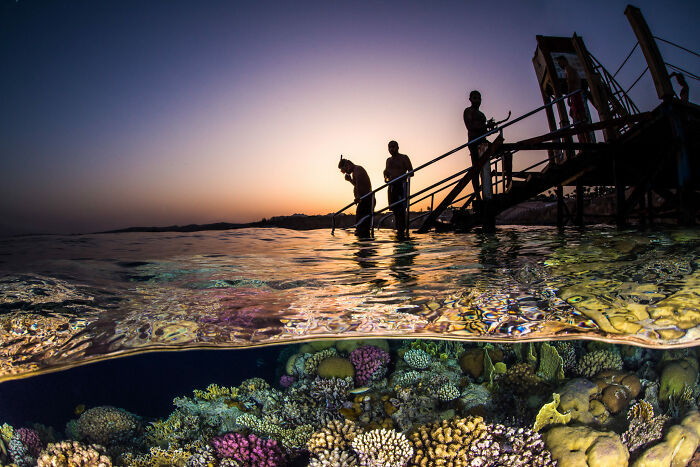
Image credits: oceanphotographyawards
#22 Finalist, Conservation (Impact) Photographer Of The Year
André Musgrove, Bahamas. A woman lies on the seabed, surrounded by fragments of a dead coral reef. "This photo shows how we have become engulfed by our own destruction as a result of poor climate change practices," says photographer André Musgrove. "I wanted to bring attention to the issue of coral reef death due to both natural and human causes. With the rise of climate change, nations like The Bahamas have become increasingly susceptible to stronger hurricanes that have wreaked havoc on Bahamian islands."

Image credits: oceanphotographyawards
#23 3rd Place, Adventure Photographer Of The Year
Martin Broen, Mexico. "Shot in an abandoned sinkhole-like cenote, where the organic matter that has fallen in the water has decomposed and generated a Hydrogen Sulphide cloud around it," says photographer Martin Broen, "It creates a spooky atmosphere accentuated by the natural framing and darkness of the cenote. It is a unique and strange natural environment, and a dream-like experience, like floating within in a haunted forest."
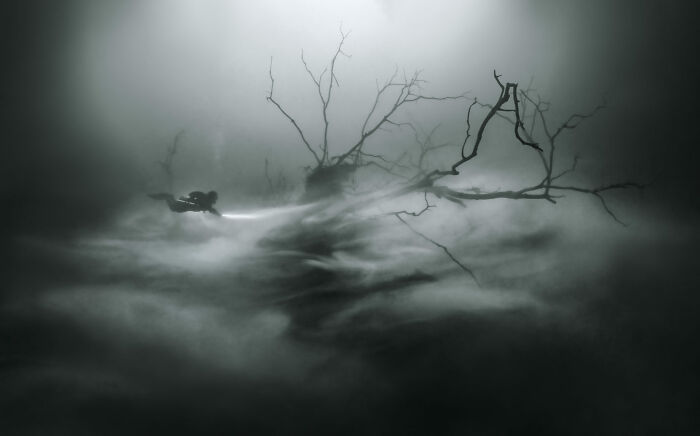
Image credits: oceanphotographyawards
#24 1st Place, Conservation (Impact) Photographer Of The Year
Simon Lorenz, Sri Lanka.
"When searching for whales in the open ocean we always inspect islands of flotsam as they can be interesting wildlife aggregators," says photographer Simon Lorenz. "This large ghostnet island was a death trap for an Olive Ridley sea turtle which we found entangled and struggling. She still looked healthy and strong so, when approaching her we had to be careful not to aggravate her. Getting her disentangled took a machete and more than 30 minutes of hard work. When all the netting was removed we checked the turtle over and sent her on her way."
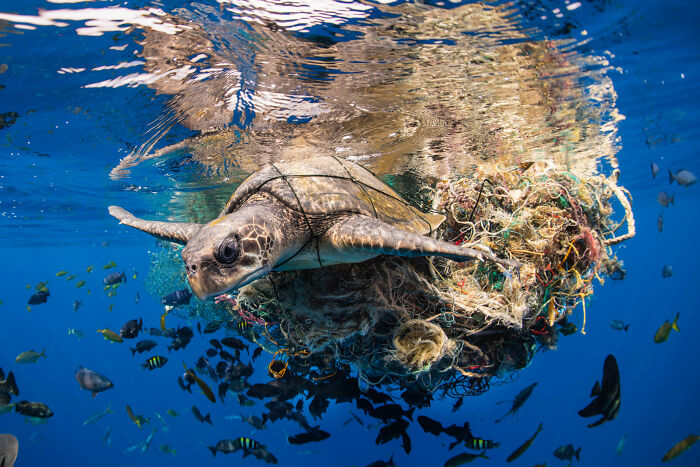
Image credits: oceanphotographyawards
#25 Finalist, Adventure Photographer Of The Year
Khaichuin Sim, Malaysia. A freediver dives into a school of jackfish. "I always wanted to create an image of a human 'coexisting' with the underwater world," says photographer Khaichuin Sim. "My wife is a skilled freediver, so on this shoot I asked her to dive towards the middle of this school until I got this beautiful image of her surrounded with storm of jackfish."
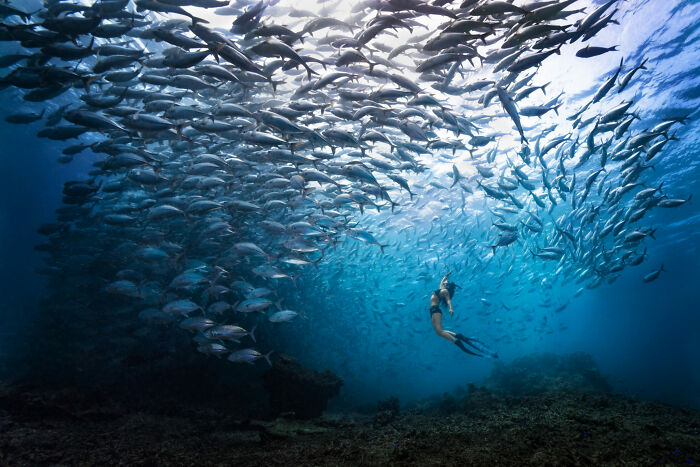
Image credits: oceanphotographyawards
#26 Finalist, Conservation (Impact) Photographer Of The Year
Pasquale Vassallo, Italy. "This winter, I collaborated with AMP Regno di Nettuno from the islands of Ischia and Procida, to produce a guide of the most beautiful dives on the two islands," says photographer Pasquale Vassallo. "During a dive at one of the sites, I was on the boat and noticed something strange on the surface. I decided to check what it was. As I swam closer, through the jellyfish, I realised, to my great sadness, that it was a sea turtle carcass. Its carapace was broken, most probably by the propeller of a boat. The animal was also lying in a large amount of rubbish, abandoned in the sea by us humans."

Image credits: oceanphotographyawards
#27 Finalist, Conservation (Impact) Photographer Of The Year
Simone Caprodossi, Dubai. Sharks lined up at a fish market. "Several years ago, visiting the Dubai Fish market on any day, you would find hundreds of sharks - species I could only dream of encountering underwater - lined-up, lifeless, waiting to be auctioned. Endangered sharks like this smooth hammerhead were often traded from Oman to the UAE, their fins destined to the Asian markets. After their listing on CITES in 2014 much of this trade has become regulated and the UAE has fully protected the species, so these scenes are hopefully a memory from the past in Dubai, but remain a crude reality in many countries where protection is not yet in place."

Image credits: oceanphotographyawards
#28 Finalist, Conservation (Impact) Photographer Of The Year
Ishino Shota, Japan. A turtle passes a bleached reef. "Due to the high water temperatures in the summer, the entire coral reef system in this area was seriously damaged," says photographer Ishino Shota. "Almost all of the zooxanthellae that aids the coral's biological activity has gone. A turtle swims past, as if observing the human destruction inflicted upon the reef."
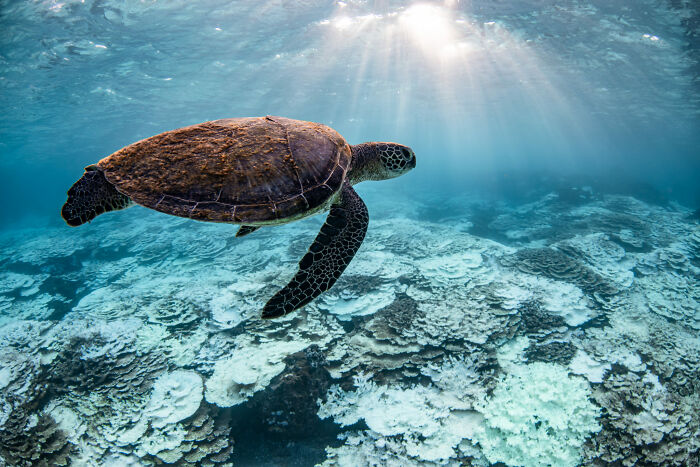
Image credits: oceanphotographyawards
#29 Finalist, Adventure Photographer Of The Year
Christophe Mason-Parker, Seychelles. "My wife and I were snorkelling over the vast seagrass beds that surround Desroches Island in Seychelles," says photographer Christophe Mason-Parker. "I wanted to capture an image of her snorkelling close to shore that highlighted the healthy Thalassodendron meadows, along with the coconut palms, which fringe the shoreline."
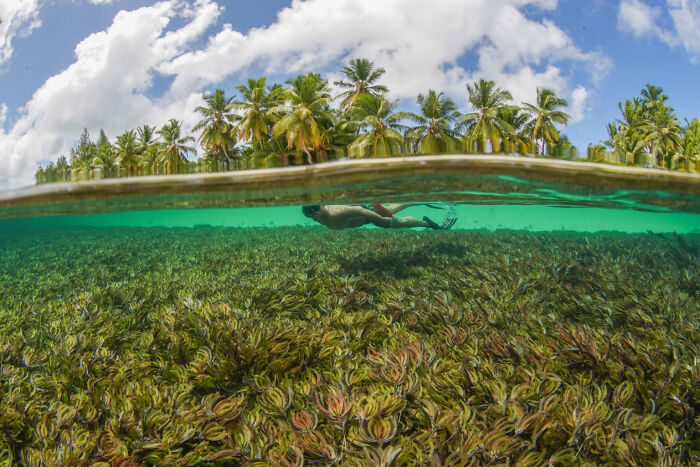
Image credits: oceanphotographyawards
#30 Finalist, Adventure Photographer Of The Year
Fabrice Guerin, Mexico. "In the heart of a silence just interrupted by my air bubbles, darkness gives way to this freediver that goes back and forth from the bottom of this cenote to the surface," says photographer Fabrice Guerin. "This freshwater sinkhole, calm, clear and without current, is ideal for training. A sulfur cloud located about twenty meters below reflects the sun rays which then work a real miracle. Originally the hydrogen sulphide layer is flat, but as we enter it repeatedly, clouds form, giving us an impression of underwater waves."
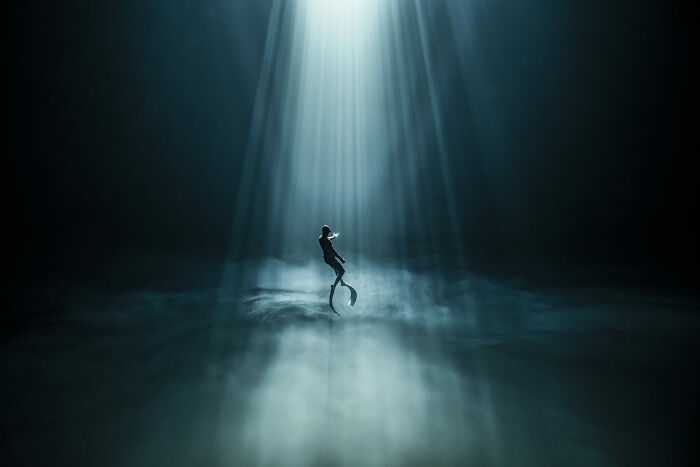
Image credits: oceanphotographyawards
#31 1st Place, Adventure Photographer Of The Year
Tom St George, Mexico. "Safety, conservation and team diving are integral to cave diving, and cave diving photography is no different," says photographer Tom St George. "It is very much a team effort. Featured in this photograph is Ellen Cuylaerts, who hovers motionless and awestruck after passing through a series of small passages and emerging to a view of these gigantic formations, that took millennia to form, and that she is seeing for the first time!"
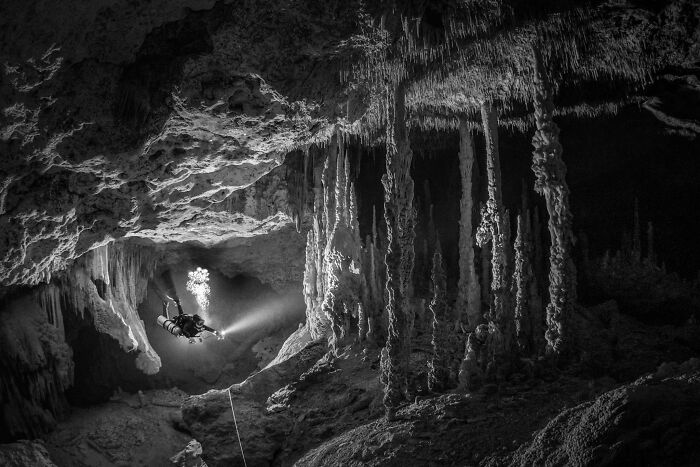
Image credits: oceanphotographyawards
#32 Finalist, Fine Art Photographer Of The Year
Brooke Pyke, Western Australia. "This day was special. The kind of day you wish would never end," says photographer Brooke Pyke. "The ocean was the glassiest I have ever seen it - a dream. I swam alongside this whale shark for around 40 minutes admiring its perfect reflection. Trying to capture this perfection was a challenge - if I dived down it disturbed the water. As I began to let the shark go, I caught a glimpse of a new angle and had to capture it. I will never have this moment again."
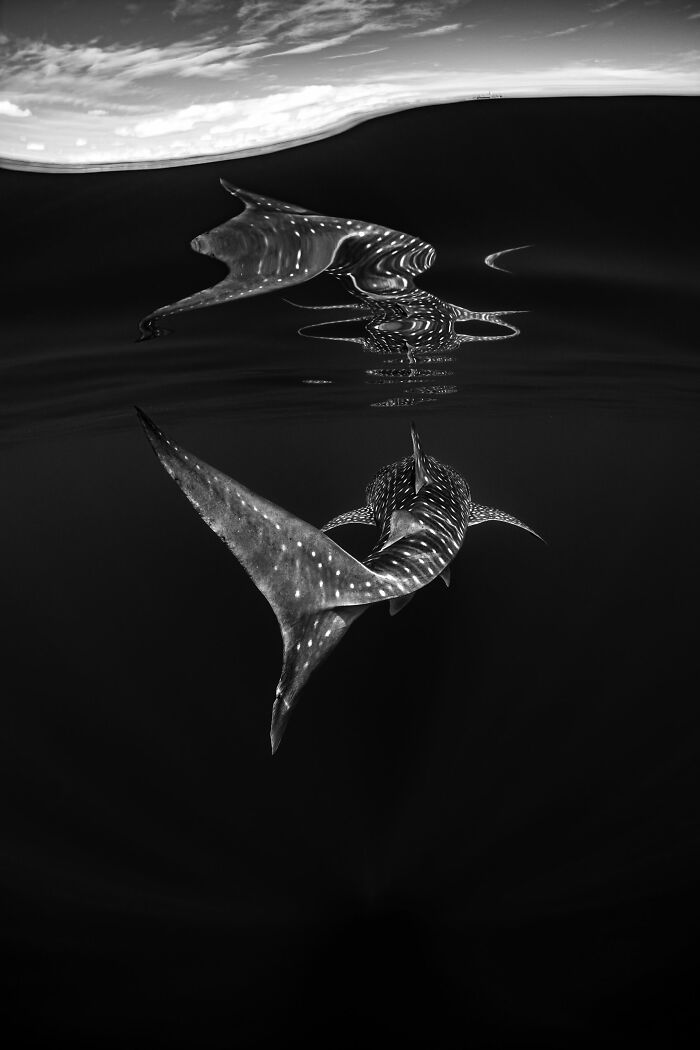
Image credits: oceanphotographyawards
#33 Finalist, Fine Art Photographer Of The Year
Gabriel Barathieu, Mayotte. "I took this photo during the first test dive of a new rig - Canon R5 in a Seacam housing. It was also the first time I used a wide angle lens during a night dive," says photographer Gabriel Barathieu. "I was secretly hoping to meet a squid for long exposure tests with rear-curtain synchronisation. That's why I took the 14-35mm lens, to be closer to the subject. After 15 minutes of diving, I came face-to-face with this squid and spent 30 minutes having fun with long exposures and flashes in stroboscope mode."
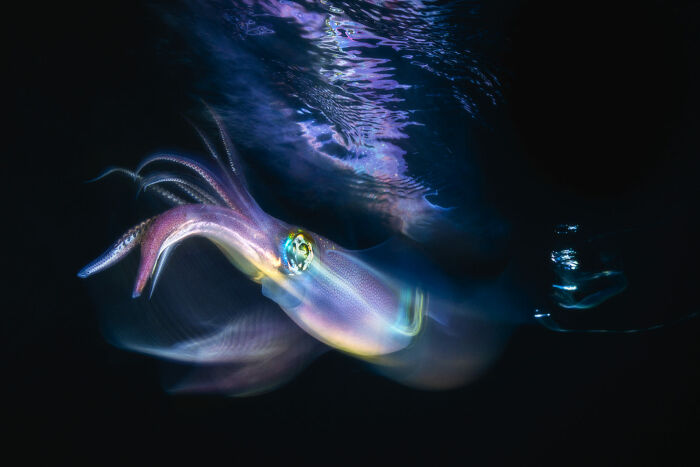
Image credits: oceanphotographyawards
#34 Finalist, Fine Art Photographer Of The Year
Gergo Rugli, Australia. A seagull flys past a large wave breaking in the light of the rising sun. "The mysterious yellow light and the flying bird inspired me to call this image Griffin as this half-eagle, half-lion mythical creature is mostly represented as a yellow bird-like creature," says photographer Gergo Rugli.
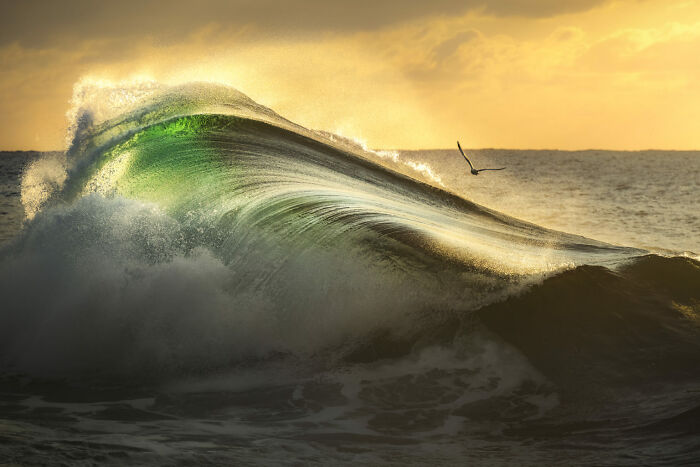
Image credits: oceanphotographyawards
#35 Finalist, Wildlife Photographer Of The Year
Florian Ledoux, Svalbard, Norway. Aerial view of a large male polar bear. "This bear had just left the old, thick, fast ice to explore the thin and freshly frozen sea," says photographer Florian Ledoux. "The newly formed ice creates some unique patterns. Out here, in the extreme cold, the light, the ice and the seascape create a kind of open-air art gallery where every day the art changes. Nature is infinite art."

Image credits: oceanphotographyawards
#36 2nd Place, The Ocean Photographer Of The Year
Katherine Lu, Philippines. A blanket octopus displays its beautiful colours and textures. "I was very sick during this dive," says photographer Katherine Lu. "I spent a lot of time trying to equalise near the surface. When my guide frantically signalled for me to come down I hesitated for moment, but went for it, pushing myself down. Luckily my ears equalised and there before my eyes was this beautiful blanket octopus. We swam alongside her and then, like magic, she opened up her blanket to show herself in all her glory."
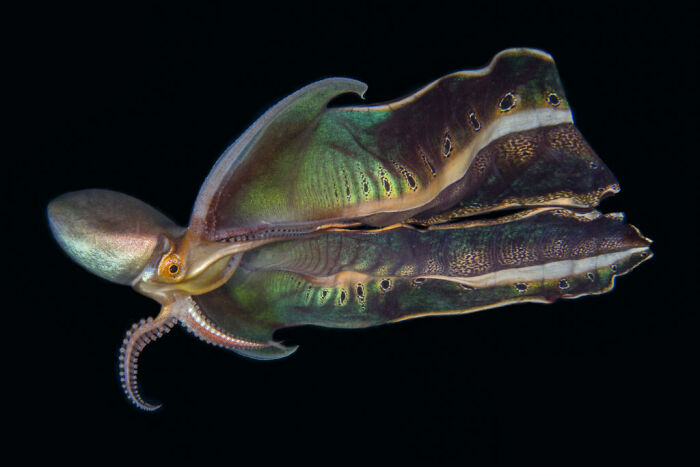
Image credits: oceanphotographyawards
#37 2nd Place, Conservation (Impact) Photographer Of The Year
Rafael Fernandez Caballero, Mexico. A dead sperm whale beached and bloody, its tail showing signs of entanglement. "Seeing a dead animal is always sad," says photographer Rafael Fernandez Caballero, "but seeing a huge mammal dead, like this sperm whale, is indescribable. From land the scene was terrifying, but from the air the situation was even more shocking and dramatic. The river of blood stretched for perhaps more than a mile."
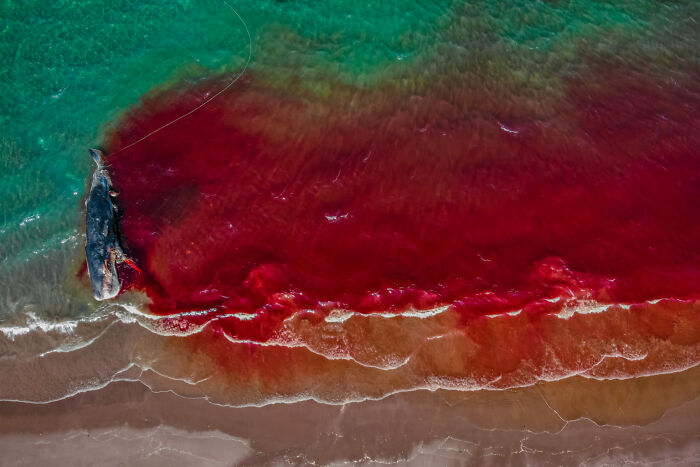
Image credits: oceanphotographyawards
#38 Finalist, Wildlife Photographer Of The Year
Dr Nick More, Cornwall, UK. A blue shark photographed off the UK coast during summertime. "We encountered between 10-20 on this particular day," says photographer Nick More. "The sharks are bold, confident and curious. I chose a slow shutter speed combined with accelerated panning to capture the beauty, grace and speed of these charismatic predators, resulting in a dynamic portrait of a stunning species in its open ocean environment. The skipper and orange RIB are rendered in a painterly way in the background, due to the intentional camera movement."

Image credits: oceanphotographyawards
#39 Finalist, Adventure Photographer Of The Year
Franco Banfi, Russia. A freediver exercises dynamic apnoea below an iced platform, in the chilly salt water of the White Sea, at -2 degrees Celsius. "You have to be extremely prepared, brave and self-controlled to freedive," says photographer Franco Banfi. "Reaching this underwater world is an adventure in itself - a thick layer of ice freezes over the entry points every night due to very low temperatures, and every day one must new cut ice holes to regain access."

Image credits: oceanphotographyawards
#40 Finalist, Human Connection Award: People & Planet Ocean
Thien Nguyen, Vietnam. The protected mangrove forest of Ru Cha, in the Tam Giang lagoon, Thua Thien-Hue Province, Vietnam. "This aerial image of the mangrove forest expresses the connection between humans and nature, and how we rely on nature to survive," says photographer Thien Nguyen Ngoc.

Image credits: oceanphotographyawards
#41 2nd Place, Fine Art Photographer Of The Year
Dr Nick More, Manado, Indonesia. A porcelain crab feeding. "The porcelain crab is a very common but charismatic critter that lives in a symbiotic relationship with their host anemone," says photographer Dr Nick More. "They wave their fan like setae, to catch food in the current. The lighting, here, is a single Inon Z240 strobe behind the anemone skirt, to backlight the crab in the act of catching its food in a raging current. A fast shutter speed provides the black background."

Image credits: oceanphotographyawards
#42 Finalist, Adventure Photographer Of The Year
Lucie Pollet, Mexico. A freediver returns to the surface. "I wanted to get a picture of my freediving friend blowing bubbles while ascending in the rays of light," says photographer Lucie Pollet. "I positioned myself at the right place, asked her to dive and swim up to me while blowing bubbles. After a few attempts, I got the right frame."

Image credits: oceanphotographyawards
#43 Finalist, Conservation (Hope) Photographer Of The Year
Ron Watkins, United States. "On a cool December morning while snorkelling in the clear Ginnie Springs in Florida, I was amazed at the towering cypress trees rooted in the water," says photographer Ron Watkins. "As I tried to capture their statuesque beauty, a tiny sunfish swam by providing a great reference for scale as well as emphasising the big and small life that are supported by the fragile springs. After all, water is life."

Image credits: oceanphotographyawards
#44 Finalist, Conservation (Impact) Photographer Of The Year
Magnus Lundgren, Philippines. A male paper nautilus hitches a ride on a piece of plastic debris. "These cephalopods ride on different hosts," says photographer Magnus Lundgren, "and since there is so much plastic out in the ocean today, they can often be found on junk like this."

Image credits: oceanphotographyawards
#45 1st Place, Conservation (Hope) Photographer Of The Year
Nicolas Remy, Australia. An aggregation of critically endangered grey nurse sharks at Fish Rock Island, NSW, Australia. "The sharks are often scattered around the island," says photographer Nicolas Remy, "but on that summer's day, the water temperature had dropped from 25 to 17 degrees Celsius due to upwelling, which drove the sharks to gather in the shallows in search of extra warmth. It felt great swimming amongst such a packed, natural gathering of wild sharks - no baiting. A reminder that nature can thrive, if we give it a chance."

Image credits: oceanphotographyawards
#46 Finalist, Conservation (Hope) Photographer Of The Year
Franco Banfi, Mexico. A large school of sardines move as one to evade predation in the Los Islotes rockeries, Espiritu Santo archipelago, Sea of Cortez, Mexico - a UNESCO Biosphere Reserve since 1995. "These tiny sardines had limited chances of survival - stuck between the surface and the shallow bottom, with very few possibilities for escape," says photographer Franco Banfi. "The school was so big it blocked the natural light coming through from the surface, darkening the scene. It continually changed shape, like a flock of starlings in the sky. I stayed for hours in the shallow water, doing my best to take a representative picture."

Image credits: oceanphotographyawards
#47 Finalist, Conservation (Hope) Photographer Of The Year
Renee Capozzola, Philippines. A turtle takes a rest on the reef off Apo Island in the Philippines. "Apo Island is home to a community-organised marine sanctuary. The concept was introduced to the local fishermen in 1982, and has been the inspiration for many more sanctuaries in the Philippines since," says photographer Renee Capozzola.
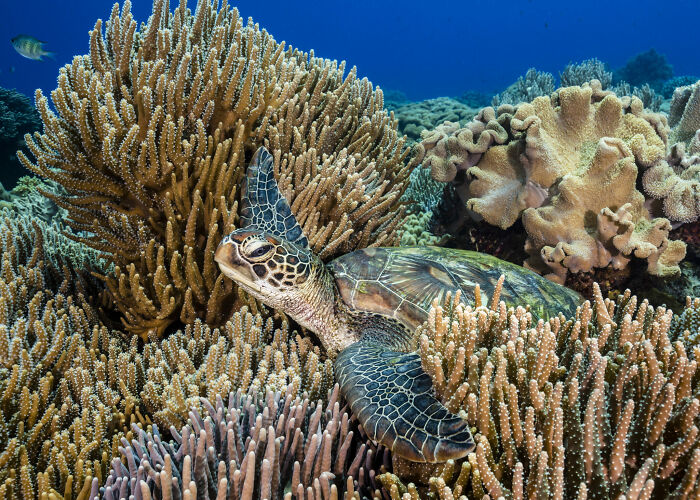
Image credits: oceanphotographyawards
#48 2nd Place, Wildlife Photographer Of The Year
Martin Broen, Quintana Roo, Mexico. A seemingly giant blue crab. "On the way back from a scooter ride connecting seven different cenotes where the Ox Bel Ha cave system meets the sea, in the darkness of the cave I saw the silhouette of a creature cut against the light coming from the hole in the cave above. I had to stop to shoot the photo. The Blue Crab, “fishing” in the cave current, looked like a menacing samurai with its dark armour, perfectly framed by the shadows of the cave and textures of the mangrove behind."

Image credits: oceanphotographyawards
#49 3rd Place, Young Photographer Of The Year
Julian Jacobs, United States. "Ten weeks after rupturing my eardrums in a scuba diving accident, I got the ok to head back into the ocean," says photographer Julian Jacobs. "On my return to my favourite reef, I was met with the king tide. The visibility was almost nonexistent so I began to think about heading in. At that moment, hundreds of seabirds took to the skies around me - they were chasing bait balls. I swam over to the aggregation, carefully inching closer to the seabirds. As the waves washed over me, I framed the moment, an over/under shot of a juvenile brown pelican and its turbulent home."

Image credits: oceanphotographyawards
#50 3rd Place, Ocean Portfolio Award
Jake Wilton, Australia. A green sea turtle cruises the abundant coral gardens of the Ningaloo Reef. "After shooting turtles with natural light for more than two years, I finally purchased some strobes," says photographer Jake Wilton. "I wanted to capture the beautiful early morning sun rays along with the details of the turtle and coral gardens which is something I was struggling to achieve with just natural lighting. I managed to capture this image as the turtle moved from one patch of reef to the next in search of more food. Anticipating where the turtle was heading I took a breath and dived into position framing my shot with the coral and sun rays, capturing the image as the turtle passed by."

Image credits: oceanphotographyawards
#51 Finalist, Human Connection Award: People & Planet Ocean
Joshua Munoz, French Polynesia. "Every winter humpback whales migrate north from Antarctica to French Polynesia, to warmer waters to give birth and mate," says photographer Josh Munoz. "Calves are curious and often leave their mother's side to interact with us in the water - the mother always keeping one eye on her newborn."
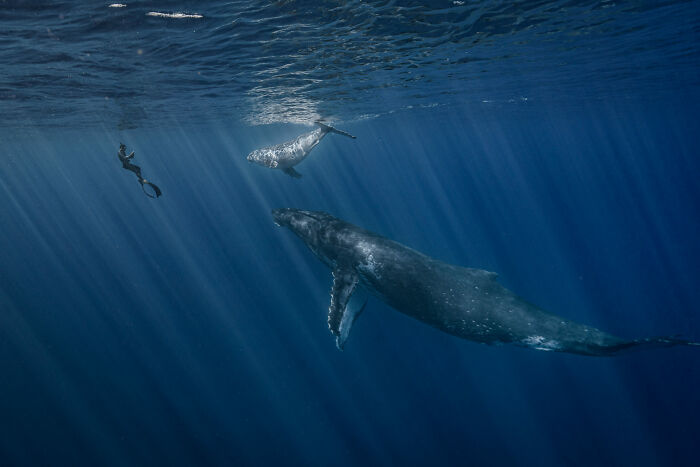
Image credits: oceanphotographyawards
#52 2nd Place, Young Photographer Of The Year
Nicolas Hahn, Mexico. "This image was shot during my first encounter with orcas in the Sea of Cortez," says photographer Nicolas Hahn. "These magnificent animals cruised past me at a relaxed pace. Playfully, the calf turned upside down and showed its white belly. Witnessing the close bond between mother and calf in the fathomless ocean was a powerful and emotional experience. It is my hope as a photographer that capturing and sharing moments like these can transmit some of the rich feelings that this sight originally evoked."

Image credits: oceanphotographyawards
#53 Finalist, Human Connection Award: People & Planet Ocean
Max Holba, Indonesia. "A local fisherman from Alor, Indonesia, leans over the side of his boat," says photographer Max Holba. "With the help of his hand-crafted wooden goggles he peers into the abyss looking for his 'bubu' - a hand-woven bamboo fish trap and traditional fishing method."

Image credits: oceanphotographyawards
#54 Finalist, Fine Art Photographer Of The Year
Vanessa Mignon, Indonesia. "I was diving the Liberty shipwreck, but there were too many divers on the site," says photographer Vanessa Mignon. "I looked around for other subjects to look at. Initially I saw a couple of nice crinoids so I got closer to them. In doing so, I noticed a little porcelain crab on an anemone. There was a bit of current so it took a few attempts to get this picture because the anemone was moving and folding in different ways, and the crab was also moving. Eventually I got this picture of the crab holding on to the edge."

Image credits: oceanphotographyawards
#55 Finalist, Fine Art Photographer Of The Year
Ben Thouard, French Polynesia. The final moments before a storm. "To this date, this is the most memorable moment that I have spent in the ocean," says photographer Ben Thouard. "The last moment of light combined with the glassy water and the heavy storm coming in out the back made for a stunning situation. This image was shot during the very last seconds before the storm hit. The next minutes were a different story: 50-knot winds and heavy rain that made the way home a little challenging."

Image credits: oceanphotographyawards
#56 Finalist, Fine Art Photographer Of The Year
Sean Scott, Western Australia. "This is part of a collection of new work titled FLOW," says photographer Sean Scott. "It focuses on my life-long obsession and fascination of the movement of water. This is an abstract image taken under a breaking wave capturing the beauty and power of the ocean. Taken at first light with a slightly extended exposure to capture the movement and moment a wave breaks while looking out to the beautiful sunrise colours."

Image credits: oceanphotographyawards
#57 Finalist, Conservation (Hope) Photographer Of The Year
Ishino Shota, Japan. Corals off Okinawa, Japan, spawn during the full moon in May. "The corals spawn countless pink bundles that contain sperm and egg," says photographer Ishino Shota. "The spectacle looks like innumerable stars twinkling in the universe. This large-scale spawning happens for only two days a year in the same area."

Image credits: oceanphotographyawards
#58 Finalist, Human Connection Award: People & Planet Ocean
Karim Iliya, Hawaii. A surfer paddles out through the white water in Hawaii. "When a wave breaks it creates a mixture of air and water that is dynamic and constantly changing," says photographer Karim Iliya. "From above it can look calm and beautiful, but beneath the surface there is chaos as plumes of air push down towards the reef like angry thunder clouds. When you are inside the white water, it looks like an avalanche passing over you, with bubbles and foam everywhere. Eventually the energy dissipates and the water changes from a sea of white to the blues of the ocean."

Image credits: oceanphotographyawards
#59 Finalist, Conservation (Impact) Photographer Of The Year
Judith Van De Griendt, Azores, Portugal. A Bryde’s whale trailing a discarded fishing net of at least 12 metres. "We knew the whale's only chance of survival was for us to cut the net with a knife while freediving," says photographer Judith van de Griendt. "We felt helpless and emotional when, after a couple of attempts, we had to decide to let the whale go."

Image credits: oceanphotographyawards
#60 3rd Place, Wildlife Photographer Of The Year
Juan Mizael Palomeque Gonzalez, Isla Mujeres, Mexico. Beautiful manta symmetry. "This was a beautiful day," says photographer Juan Mizael Palomeque Gonzalez. "The ocean was glassy calm and what I saw was magical. I could not keep track of how many whale sharks and mantas welcomed us. Just me and my wife surrounded by gentle giants, I could not ask for more."

Image credits: oceanphotographyawards
#61 Finalist, Conservation (Impact) Photographer Of The Year
Thien Nguyen, Vietnam. An aerial view of the lobster farming area off the coast of Hon Yen, Phu Yen province, Vietnam. "Lobster farming is a growing industry in Vietnam and part of the long-term plan of the country’s Ministry of Agriculture and Rural Development. The demand for seafood is increasing dramatically, not only in Vietnam but worldwide."

Image credits: oceanphotographyawards
#62 Finalist, Adventure Photographer Of The Year
Brandi Mueller, Mexico. "The massive sunbeams filtering into Cenote Azul Ha on this day were strong enough to light a diver and the cavern walls," says photographer Brandi Mueller. "The clarity of the water makes it look as if the diver is floating in air, flying next to the light."

Image credits: oceanphotographyawards
#63 Finalist, Human Connection Award: People & Planet Ocean
Pier Nirandara, Bahamas. Atlantic spotted dolphins and a freediver in Bimini, The Bahamas. "Summertime can bring crystal clear conditions, allowing sunlight to penetrate the glassy surface down through the entire water column," says photographer Pier Nirandara. "This group of dolphins twirled and danced with us. There’s something magical about swimming with marine megafauna that wants you around."

Image credits: oceanphotographyawards
#64 1st Place, Ocean Portfolio Award
Matty Smith, Australia. "A wonderfully unique event to witness in South Australia is the annual Giant Cuttlefish Aggregation," says photographer Matty Smith. "Taking place from May to August an estimated 250,000 cuttlefish gather around Point Lowly off the small industrial town of Whyalla to fight and breed. Moments before this frame I had been observing three large males all trying to court a single female. As I approached a fight broke out between two males and they inked the water as they furiously grappled each other. Their fight rolled out of frame, the female bolted, and this one male was left in the aftermath, still displaying his vivid courting colours."

Image credits: oceanphotographyawards
#65 Finalist, Adventure Photographer Of The Year
Karim Iliya, Tonga. A freediver swims amongst a school of fish in a cave in Tonga. "Many fish school in large groups to increase their chances of survival and confuse predators with their movements," says photographer Karim Iliya. "Here in this cave, they are also protected from many of the larger animals that might eat them in the open ocean. No matter how many times I come here, I always find a new way to look at it. It is one of my favourite places on Earth, a place where I can find peace in a world beneath the water."

Image credits: oceanphotographyawards
#66 Finalist, Human Connection Award: People & Planet Ocean
Joao Pompeu, Portugal. "Nazaré is widely known for its big waves, attracting hundreds of people worldwide to contemplate this amazing and beautiful demonstration of ocean power," says photographer Joao Pompeu. "I knew about the swell for big waves just two days before it. I managed to pick up a car in Northern Spain and drove 15 hours through the night, arriving at 6am in Nazaré. It was still dark, but I mounted my tripod where I found the composition and waited. The moment of three giant waves breaking with a perfect light lasted less than one minute, but was worth all the effort."

Image credits: oceanphotographyawards
#67 Finalist, Wildlife Photographer Of The Year
Massimo Zannini, Capo Noli, Italy. The goose fish arrives to shallower, Italian shores in spring. "For the rest of the year it lives at near abyssal depths," says photographer Massimo Zannini. "This portrait shows the fish opening its mouth to catch a meal."

Image credits: oceanphotographyawards
#68 1st Place, Fine Art Photographer Of The Year
Mike Spencer, Scarborough, UK. Crashing waves in the North Sea, UK. "Seascapes are a photographic passion of mine, whether wild, calm, or anything between," says photographer Mike Spencer. "Wintertime is best for big swells and storms and I constantly monitor the charts to spot potential photo opportunities. This particular January week was showing clear calm conditions with a good swell period. I love the ‘golden hour’, especially early morning, when there may be the bonus of mist. The North Sea coast of the UK is perfect for sunrises. This picture was taken about an hour after sun-up and the sea state was calm. Sets were quite spacious so I waited, having noted that the offshore wind was increasing. Then, a bit like buses, you wait for ages then three come at once - three breaking peaks in this case. With the mist rolling off the fields and over the cliff edges in the background my image was captured. Time to put my wetsuit on and grab my board – happy in the knowledge that I may just have ‘something’!"

Image credits: oceanphotographyawards
#69 3rd Place, Fine Art Photographer Of The Year
Martin Broen, Baja California, Mexico. Blue whales in black and white. "Sometimes you plan a photo and sometimes you are just lucky to be in the right place at the right time for nature to amaze you, and that’s the case with this photo," says photographer Martin Broen. "All week we'd been capturing the mobula ray migration in Baja California when we saw whales on the horizon. Moments later we were freediving in front of these passing blue whales."

Image credits: oceanphotographyawards
#70 2nd Place, Adventure Photographer Of The Year
Franco Banfi, Dominica. A freediver swims with a matriarchal pod of five sperm whales. "Being accepted into their intimacy is not for everybody," says photographer Franco Banfi. "Only the more respectful, self-controlled, patient, relaxed and in tune with their elusive world succeeds. You have to give the whales time to know us, to scan our body with gentle clicks, to understand if we are a danger or a playmate. With wildlife, gentle interactions can happen only if we enter their element on tiptoes - nothing good happens when we are in a hurry." The picture was taken under Government permit RP 16-02/32 FIS-5.

Image credits: oceanphotographyawards
#71 Finalist, Adventure Photographer Of The Year
Lucie Pollet, Mexico. "Early morning, we took the boat to find the school of jacks in the Marine Park of Cabo Pulmo," says photographer Lucie Pollet. "We freedived with them, above them, into the school. "There was little light as it was very early, giving space for this deep blue. I was following my friend who was freediving next to the school and enjoying the beauty. I took this picture from far away to show how beautiful and immense the school was Such moments are unforgettable."

Image credits: oceanphotographyawards
#72 Finalist, Conservation (Impact) Photographer Of The Year
Rafael Fernandez Caballero, Spain.

Image credits: oceanphotographyawards
#73 Finalist, Conservation (Hope) Photographer Of The Year
Lucie Pollet, Egypt. "This large pod of spinner dolphins hunt in the open ocean during the night before returning in the early morning to the Sataya reef lagoon to rest," says photographer Lucie Pollet. "They spend the day in the lagoon to rest, play, mate and learn. On this particular morning, the dolphins were curious and in a playful mood. We spent two hours with them, interacting. My heart was jumping with happiness and excitement. It was an amazing encounter."

Image credits: oceanphotographyawards
#74 Finalist, Conservation (Hope) Photographer Of The Year
Alexis Rosenfeld, French Polynesia. "This photo is part of a programme I am carrying out with UNESCO:1 OCEAN," says photographer Alexis Rosenfeld. "This is scientific diver / biologist, Yann Lacube, from CRIOBE who works on CNRS researcher Laetitia Hedouin's team. The team works on corals that are resistant to global warming. Here Lacube is selecting a coral that is undergoing a bleaching episode."

Image credits: oceanphotographyawards
#75 3rd Place Human Connection Award: People & Planet Ocean
Radim Klimes, Australia. "For me, this image was all about capturing the aesthetic power that the ocean allows humans to embody," says photographer Radim Klimes. "I found it important for the primary focus to be free from distraction and thus decided to shoot in an overcast setting and edit in black and white. This is my personal interpretation of how the ocean allows for elegance in a unique and powerful way."

Image credits: oceanphotographyawards
#76 Finalist, Conservation (Hope) Photographer Of The Year
Joe Daniels, Seychelles. "In recent years coral bleaching events have become increasingly frequent in Seychelles," says photographer Joe Daniels. "As a result, various conservation organisations across the archipelago have made coral nurseries, where fragments of coral are gown on frames and planted out onto a degraded area of reef in order to aid its recovery. It's an important tool to protect coral reefs amidst our changing climate. This image was shot during a dive to keep the frames and fragments clean of algae."

Image credits: oceanphotographyawards
#77 Finalist, Conservation (Hope) Photographer Of The Year
Steven Walsh, Australia. "Diving with weedy seadragons is always an experience. On rare occasions we even get to see juveniles, who despite their beautiful colourations, camouflage exceptionally well," says photographer Steve Walsh. "The behaviour captured in this image is something else though. Weedy seadragons are usually solitary. Schooling behaviour like this is largely unheard of. I’m so grateful to have witnessed it. It goes to show we still know so very little about these fish."

Image credits: oceanphotographyawards
from Bored Panda https://ift.tt/cmP4GHC

